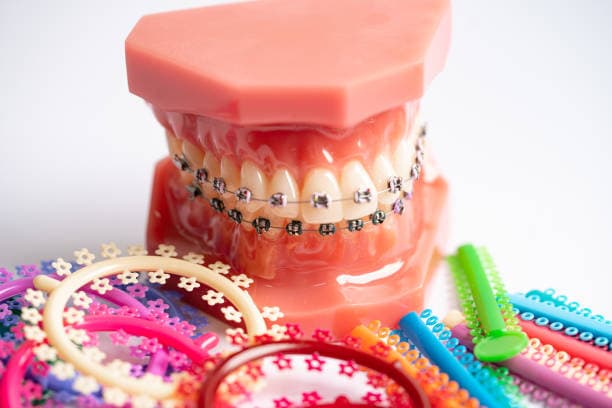Orthodontic treatment is a transformative process aimed at correcting misaligned teeth and jaws to achieve a healthier, more functional, and aesthetically pleasing smile. This journey typically unfolds through several well-defined stages, each crucial for ensuring successful and lasting results.
Orthodontic Treatment Steps
Orthodontic treatment involves several distinct stages designed to correct misaligned teeth and jaws, resulting in a healthier and more aesthetically pleasing smile.
The journey begins with the Initial Consultation and Diagnosis, where an orthodontist conducts a comprehensive examination using X-rays, photographs, and dental impressions to assess the patient's dental issues and create a personalized treatment plan. This is followed by the Treatment Planning stage, where the appropriate orthodontic appliances, such as braces or aligners, are selected, and the expected duration and treatment milestones are outlined.
The Active Treatment Phase then commences, during which the selected appliances are applied to the teeth. Regular adjustments and follow-up appointments are necessary to gradually move the teeth into their desired positions. This phase can last from several months to a few years, depending on the complexity of the case. Throughout this period, patients must maintain good oral hygiene and adhere to their orthodontist's instructions to ensure optimal progress.
Finally, the Retention Phase is crucial for maintaining the new alignment of the teeth and preventing relapse. Retainers are used to keep the teeth in their corrected positions, ensuring the longevity of the treatment results. Understanding these stages helps patients prepare for their orthodontic journey, fostering cooperation and commitment to achieving a beautiful, healthy smile.
The initial exam
The initial exam in the orthodontic treatment process is a crucial step that sets the foundation for a successful journey toward a healthier, more aligned smile. During this comprehensive evaluation, the orthodontist conducts a thorough assessment of the patient's dental and facial structures. This typically involves taking detailed X-rays, photographs, and dental impressions to obtain a complete understanding of the teeth, jaw, and bite alignment. These diagnostic tools provide valuable insights into the underlying issues, such as crowding, spacing, overbites, underbites, and other malocclusions.
The orthodontist also performs a clinical examination, which includes checking the patient's oral health, looking for signs of tooth decay, gum disease, and other dental problems that might affect the treatment plan. During this stage, the orthodontist discusses the patient's concerns and goals, ensuring that the treatment plan aligns with their expectations and needs. They also explain the various treatment options available, such as traditional braces, clear aligners, or other orthodontic appliances, and the potential duration of the treatment.
This initial consultation is an opportunity for the patient to ask questions and gain a clear understanding of the proposed treatment plan. It helps build trust and confidence in the process, laying the groundwork for a cooperative and successful orthodontic experience.

Preparing for braces
Preparing for braces in the orthodontic treatment process is a vital step to ensure a smooth and successful experience. Before getting braces, the orthodontist will conduct a thorough examination, which includes taking X-rays, photographs, and dental impressions to create a detailed map of the teeth and jaw structure. This initial assessment helps the orthodontist develop a customized treatment plan tailored to the patient's specific needs.
Once the treatment plan is established, the orthodontist will discuss the different types of braces available, such as traditional metal braces, ceramic braces, or clear aligners, and help the patient choose the most suitable option. The patient will receive instructions on how to maintain good oral hygiene during the treatment, as braces can make it more challenging to keep teeth clean. This includes proper brushing and flossing techniques and the use of special cleaning tools like interdental brushes and water flossers.
Before the actual placement of braces, any necessary dental work, such as fillings or extractions, will be completed to ensure optimal oral health. The orthodontist may also recommend a professional dental cleaning to remove any plaque or tartar buildup. On the day of the braces placement, the teeth will be thoroughly cleaned and dried, and a special adhesive will be used to attach the brackets to the teeth. The procedure is typically painless and relatively quick, setting the stage for the exciting journey towards a beautifully aligned smile.

Putting the braces on
The process of putting braces on marks an exciting and important step in the orthodontic journey towards achieving a beautifully aligned smile. On the day of the procedure, the orthodontist begins by thoroughly cleaning and drying the patient's teeth to ensure the brackets adhere properly. A special adhesive is then applied to the front surfaces of the teeth, and the brackets are carefully positioned and pressed into place. Once the brackets are secure, the orthodontist uses a curing light to harden the adhesive, ensuring a strong bond.
Next, the orthodontist threads a thin archwire through the slots in the brackets. This archwire plays a crucial role in guiding the teeth into their correct positions over time. The wire is secured with small elastic bands or metal ties, which come in a variety of colors, allowing patients to personalize their braces. The orthodontist may also place additional appliances, such as spacers or bands, if needed to facilitate the treatment.
The entire process is typically painless and takes about one to two hours to complete. While some initial discomfort and pressure may be felt as the teeth begin to adjust, this usually subsides within a few days. Patients are provided with detailed instructions on how to care for their braces and manage any discomfort, ensuring a smooth transition into the active treatment phase.

Checkups
Regular checkups are an essential part of the orthodontic treatment process, ensuring that the braces are effectively guiding the teeth into their desired positions and maintaining overall oral health. Typically scheduled every 4 to 6 weeks, these appointments allow the orthodontist to monitor the progress and make necessary adjustments. During each visit, the orthodontist checks the condition of the braces, ensuring that all components are intact and functioning properly. If any brackets or wires are loose or broken, they are promptly repaired or replaced.
The orthodontist also adjusts the tension in the archwire, tightening or replacing it to continue applying the appropriate pressure needed to move the teeth. This may involve changing the elastic bands or metal ties that hold the wire in place. These adjustments are crucial for achieving the optimal movement of the teeth and ensuring that the treatment stays on track.
In addition to mechanical adjustments, the orthodontist evaluates the patient's oral hygiene and provides guidance on maintaining clean teeth and gums despite the challenges posed by braces. This may include recommending special brushes or flossing techniques to prevent plaque buildup and cavities. Regular checkups also offer an opportunity for patients to ask questions and discuss any concerns they might have about their treatment.
Taking the braces off
The process of taking off braces, often referred to as debonding, marks the exciting culmination of the orthodontic treatment journey. This procedure is typically quick and painless, starting with the orthodontist gently removing the elastic bands and archwire from the braces. Next, a special tool is used to carefully pop off the brackets from the teeth, ensuring that the enamel is not damaged. This process may create some minor pressure but should not cause significant discomfort.
Once the brackets are removed, the orthodontist will meticulously clean the teeth to eliminate any remaining adhesive. This cleaning process involves polishing the teeth, resulting in a smooth and even surface. Patients may notice that their teeth feel slightly sensitive immediately after the braces are removed, but this sensation usually subsides quickly.
Following the removal of braces, the orthodontist will take new impressions or digital scans of the teeth to create custom retainers. These retainers are essential to maintaining the newly aligned teeth and preventing them from shifting back to their original positions. The orthodontist will provide detailed instructions on how to care for and wear the retainers, emphasizing their importance in preserving the treatment results. The removal of braces is a momentous occasion, revealing a beautifully aligned smile and marking the beginning of the retention phase to ensure lasting success.

The retention phase
The retention phase is a crucial step following the active treatment phase of orthodontics, ensuring that the newly aligned teeth remain in their corrected positions. Once braces or aligners are removed, retainers are custom-made to fit the patient's mouth precisely. These retainers help to stabilize the teeth, allowing the surrounding bone and soft tissues to adapt to the new alignment. Retainers can be either removable or fixed, depending on the patient's needs and the orthodontist's recommendations.
During this phase, patients are typically instructed to wear their retainers consistently, usually starting with full-time wear and gradually transitioning to nighttime use. This period is essential to prevent the teeth from shifting back to their original positions, a process known as relapse. Regular follow-up visits with the orthodontist are necessary to monitor progress and make any needed adjustments to the retainers.
Good oral hygiene practices must be maintained, as retainers can accumulate plaque and bacteria. Patients should clean their retainers daily and continue regular brushing and flossing routines to ensure overall oral health. The retention phase may last several years or even be a lifelong commitment, depending on individual circumstances, but it is vital for maintaining the results of the orthodontic treatment and ensuring a lasting, beautiful smile.

Conclusion
In conclusion, the stages of orthodontic treatment—from the initial consultation and diagnosis to the retention phase—form a comprehensive process aimed at achieving optimal dental health and a beautifully aligned smile. Each stage plays a vital role, from the careful planning and application of braces or aligners to the regular adjustments and eventual removal of the orthodontic appliances. The retention phase ensures that the newly aligned teeth remain in place, preventing any relapse. Understanding these stages helps patients navigate their orthodontic journey with confidence and commitment, ultimately leading to long-lasting and satisfying results.
Read More